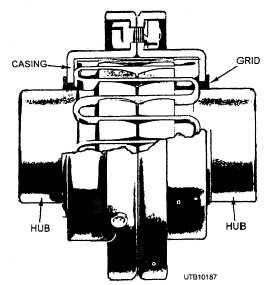When a stuffing box is fitted with a lantern ring, be sure to replace the packing beyond the lantern ring at the bottom of the stuffing box, and be sure that the sealing water connection to the lantern ring is not blanked off by the packing (fig. 6-21). Sleeves fitted at the packing on the pump shafts must always be tight. These sleeves are usually made secure by shrinking or keying them to the shaft. Be careful to ensure the water does not leak between the shaft and the shaft sleeves.
In some pumps, the shaft sleeve is pressed onto the shaft tightly by means of a hydraulic press, and the old sleeve must be machined off in a lathe before a new one can be installed. On other centrifugal pumps, the shaft sleeve is a snug slip-on fit, butted up against a shoulder on the shaft and held securely in place with a nut. On some small pumps, new sleeves can be installed by removing the water end casing, impeller, and old shaft sleeves. New sleeves are carried as repair parts, or they can be made in the machine shop. On large pumps, the sleeves are usually pressed on; these pumps must be disassembled and taken to the machine shop, a repair ship, or a Navy yard to have the old sleeve machined off and a new one pressed on.
Some sleeves are packed to prevent water leakage between the shaft and the sleeve, while some have O rings between the shaft and the abutting shoulder. For detailed information, consult the appropriate manufacturer's technical manual or applicable blueprints.
Shaft alignment must be checked frequently. When the shafts are out of line, the unit must be realigned to prevent shaft breakage and damage to the bearings, the pump casing wearing rings, and the throat bushings. Shaft alignment should be checked with all piping in place.
A FLEXIBLE COUPLING may connect the driving unit to the pump. You should remember that flexible couplings (fig. 6-22) are intended to take care of only slight misalignment. Misalignment should never exceed the amount specified by the pump manufacturer. When there is excessive misalignment, the coupling parts are punished severely, and pins, bushings, and bearings have to be frequently replaced.
The driving unit may be connected, or coupled, to the pump by a FLANGE COUPLING. Frequent realignment of the shaft may be necessary. Each pump shaft must be kept in proper alignment with the shaft of the driving unit. Abnormal temperatures, abnormal noises, and worn bearings or bushings indicate misalignments.

Figure 6-22.& - Grid-type flexible coupling.
Wedges, or shims, are placed under the bases of both the driven and driving units to facilitate alignment when the machinery is installed. Jacking screws can also be used to level the units. When the pump or driving unit, or both, need to be shifted sideways to align the couplings, side brackets are welded in convenient spots on the foundations, and large setscrews are used to shift the units sideways or endwise. When the wedges or other packing have been adjusted so the outside diameters and faces of the coupling flanges run true as they are manually revolved, the chocks should be fastened, the units should be securely bolted to the foundation, and the coupling flanges should be bolted together.
These ALIGNMENTS MUST BE CHECKED from time to time and misalignments promptly corrected. There are three devices in use for checking the alignments-a 6-inch scale, a thickness gauge, and a dial indicator.
Shaft alignment should be checked whenever the pump is opened up and whenever a noticeable vibration is observed. When shafts are found out of line or inclined at an angle to each other, the unit should be aligned to avoid shaft breakages and renewal of bearings, pump casing wearing rings, and throat bushings. The appropriate technical manual should be consulted when you are aligning the pump.
In a centrifugal pump installation fitted with an internal water-lubricated bearing inside the pump casing (such as condensate pumps), an adequate supply of clean water must be supplied to the bearing for lubricating and cooling. Several of the following types of materials are used for internal water-lubricated
Continue Reading